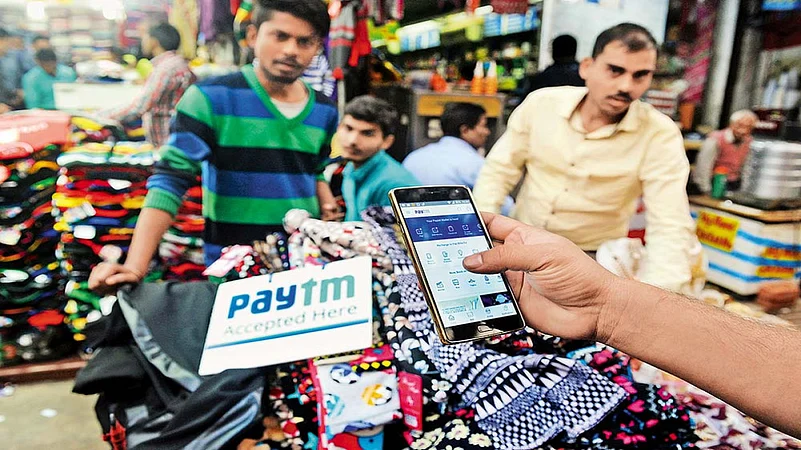If the past 18 months had a motif, many of us would be hard-pressed to find one better than the resilience of the human will. The pandemic posed near-insurmountable challenges to humanity and to the country at large. Despite the slew of challenges, Indians have time and again attested to the fact that our capacity to overcome the greatest of odds is incredible and so is our ability to innovate and adapt.
Central to this innovation and adaptability is the undercurrent of digitisation. Today, it pervades every aspect of our lives. The old dynamic of physical transactions is steadily receding, and new digital habits, seen till recently with much skepticism, are readily embraced.
Name any aspect of one’s life and it is likely to have been altered, post the pandemic. From shopping patterns, banking practices, to work dynamics, they were unrecognisably changed. Here, due credit goes to the customer for acculturating himself to a new digital way of life. While many of the adaptations were necessitated by the two major spells of lockdown, one does not foresee people reverting to the way things were before Covid-19. Even if the virus threat is completely extinguished, and one hopes that it will be so, the momentum for digitisation will not be reversed, slowed, or halted. Our new reality, new normal stands forever altered.
Ripple Effect
Digital integration took a leap in the last decade on the back of cheaper smart phones and increased internet penetration. No wonder that India is projected to become one of the largest ecosystems for internet users. A report released by a data analytics and brand consulting firm states that India is likely to become home to 900 million users by 2025. What is more interesting is that internet penetration is growing at a faster rate in rural India compared to urban India.
For micro, small, and medium enterprises (MSMEs) across the length and breadth of the country, this is great news. Evidently, rural areas are at a tipping point that will help the smaller firms to unlock greater value in their businesses.
Deeply related to the development around MSMEs is the quantum of the unbanked in India. The Pradhan Mantri Jan-Dhan Yojana, boosted by Reserve Bank of India’s sustained financial inclusion campaigns led to tremendous success. In 2017, at least 80% of the population had bank accounts. However, holding a bank account hasn’t necessarily translated into meaningful inclusion. RBI data shows that there has been little improvement in terms of account usages, financial literacy and saving habits, and institutional borrowings. With 5 per cent of MSMEs digitised, as per a survey by a private bank, increased technology use in the decade to come will aid in greater geographic reach, and better efficiency of businesses, in addition to increasing India’s competitiveness in global markets.
A Digital Economy
To remedy the lack of financial access and literacy, a draft policy, USENET or Udyog Sahayak Enterprises Network, aims to empower over 62 million nano and micro-enterprises, basically the kiranas and mom-and-pop stores, with a support system that will catalyse ease of business. This will be done through digitisation and formalisation of their businesses. This will further aid them to integrate their operations—from billing to ordering, managing staff to migrating business online, and from filing taxes to enhancing customer loyalty—on one device.
ALSO READ: When Liberalisation Freed India Inc
However, an accelerated digitisation—be it adoption of digital payments, card-based as well UPI, coupled with a new framework around easy access to credit—will help them in availing loans and subsidies, ensure compliance with regulations and accelerate assimilation with digital payment platforms.
It is these kirana stores and small shops that hold the key to unlocking India’s immense economic potential in the next 10-15 years. Connecting them with the mainframe of banking architecture will not only improve the bottom line of banks but will electrify economic development. Digital banking has the potential to penetrate deeper into India’s unbanked areas and connect these hinterlands with opportunities arising in cities and towns. Mapping a digital India begins with a banking network that creates new employment avenues and business possibilities.

Digitisation In Education
Digitisation has helped other segments shed their old paradigms. For instance, the education space has seamlessly embraced digital opportunities. Teachers adapted to delivering classes virtually, and students pursued academic courses and professional degrees online.
Since 2020, Indian universities, which were earlier restricted from offering more than 20 per cent of a course online, were permitted to provide their courses online in a bid to widen the reach and scope of professional education. Compared to 2016, when India’s online education market was $247 million, it is poised to be $1.96 billion this year. The user base has swelled, and how. While only 1.6 million people were educating themselves online in 2016, the number has increased to 9.6 million.
As online education percolates deeper, costs on this sub-head will decrease substantially over the next decade, and more graduates will step out after a digital-only curriculum. This will be the new norm. Additionally, it will aid in re-skilling workforce and its accelerated transformation.
Digitisation And Managing Finances
Meanwhile, the world of finance is touching new heights in an online avatar. There is transformation at a tremendous pace, thanks to millennials who have entered the stock markets in droves and are powering the benchmark indices to new heights. For evidence that the Indian experiment with digitisation is truly up and running, consider the fact that over one crore demat accounts were opened between April 2020 and January this year.
The investors’ tryst with the markets is powered by a digitised process that cuts out the clutter of cumbersome physical documentation. Gone are the days of running to a photocopy shop and managing tons of authentication documents. With account aggregator framework in place, neo-banking is making inroads, and financial decisions will happen with few clicks and taps in the next 10-15 years.
Last, but not the least, consider the ever-widening expanse of e-commerce. As of 2020, at least 67% of online consumer demand stems from Tier 2 cities. Deeper internet penetration shattered the urban-rural divide. Accompanying this e-commerce growth is the rise of the cashless credit business models. Most prominent in this category is the buy-now-pay-later (BNPL) model. It works on a short-term, micro-credit model which allows customers to make up for their cash crunch and facilitate purchases by asking them to pay little or no interest.
This model of buying small and big-ticket items at the point of sale has been a hit with consumers, especially the millennials, as it allows them to manage their monthly spends. With credit card penetration barely at 3 per cent, or one of the lowest in the world, BNPL players will be quick on their feet in capturing markets.
Bottom Line
If there was one big lesson to be learnt from the pandemic, it is that digitisation is the new evolutionary threshold for businesses. Its transformative power can light up the blind spots, eliminate bottlenecks and remove logistical barriers in its wake. With it, the most remote locations can (and will) be mapped onto the digital landscape, and their progress and development will be monitored in real-time. Sure, this might sound utopian, but the impact of digitisation is going to be huge, one that will transform the future of our nation.
(This appeared in the print edition as "Click to Play")
(Views are personal)
ALSO READ
Nitish Asthana is president and chief operating officer, Pine Labs





















